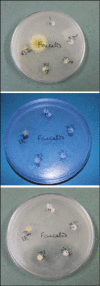Evaluation of Antibacterial Properties of Organic Gutta-percha Solvents and Synthetic Solvents Against Enterococcus faecalis
- PMID: 34036080
- PMCID: PMC8118058
- DOI: 10.4103/jispcd.JISPCD_422_20
Evaluation of Antibacterial Properties of Organic Gutta-percha Solvents and Synthetic Solvents Against Enterococcus faecalis
Abstract
Background: The use of solvents is necessary to remove remnants of filling materials within dentinal tubules to allow penetration of irrigating solution within the tubules.
Aim and objectives: We aimed at determining the antibacterial effect of various gutta-percha (GP) solvents against Enterococcus faecalis (E. faecalis).
Materials and methods: An in vitro study was conducted by measuring the zone of inhibition using the disk diffusion method. The test organism used for the study was E. faecalis, and the solvents were divided into five groups: eucalyptus oil, chloroform, turpentine oil, xylene, and orange oil. About 500 μL of the suspension was spread over the agar plates, and the empty sterilized disks were impregnated with 10 μL of pure essential oils (EOs). The inoculated plates were incubated at 37°C for 18 to 24 h. The antimicrobial activity of each solvent was expressed and measured in terms of the mean diameter of the zone of inhibition (in mm) produced by each solvent at the end of the incubation period. ANOVA was used for intergroup comparison. The P-value of <0.05 was considered significant.
Results: The mean zone of inhibition for E. faecalis was 24.00 ± 1.21 for eucalyptus oil, 16.30 ± 0.92 for chloroform, 26.50 ± 1.24 for turpentine oil, 13.70 ± 1.26 for xylene, and 19.80 ± 1.32 for orange oil. The difference between the groups was statistically significant (P < 0.001).
Conclusion: This study demonstrated that the use of turpentine oil during endodontic retreatment significantly reduced the levels of E. faecalis as compared with other solvents.
Keywords: Antimicrobial property; Enterococcus faecalis; endodontic retreatment; essential oil; gutta-percha.
Copyright: © 2021 Journal of International Society of Preventive and Community Dentistry.
Conflict of interest statement
There are no conflicts of interest.
References
-
- Stuart CH, Schwartz SA, Beeson TJ, Owatz CB. Enterococcus faecalis: Its role in root canal treatment failure and current concepts in retreatment. J Endod. 2006;32:93–8. - PubMed
-
- Sedgley C, Buck G, Appelbe O. Prevalence of Enterococcus faecalis at multiple oral sites in endodontic patients using culture and PCR. J Endod. 2006;32:104–9. - PubMed
-
- Schilder H. Message from our President: Passage. J Endod. 1986;12:177–8.
-
- Stabholz A, Friedman S. Endodontic retreatment—case selection and technique. Part 2: Treatment planning for retreatment. J Endod. 1988;14:607–14. - PubMed
-
- Magalhães BS, Johann JE, Lund RG, Martos J, Del Pino FA. Dissolving efficacy of some organic solvents on gutta-percha. Braz Oral Res. 2007;21:303–7. - PubMed
LinkOut - more resources
Full Text Sources
Molecular Biology Databases


